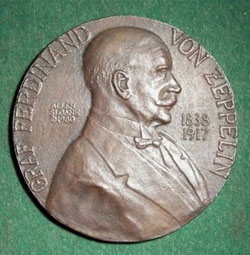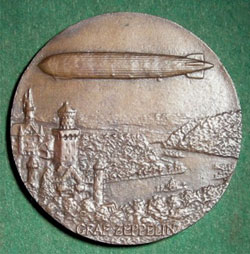

|
GRAF FERDINAND VON ZEPPELIN |
|
|
SLOANE, Allen: USA, 1980, Bronze, 101 mm Ferdinand Adolf August Heinrich Graf (Count) von Zeppelin (1838-1917) was a German aircraft manufacturer, the inventor of the rigid dirigible or airship balloon and the founder of the Zeppelin Airship Company. He was born in Konstanz, Grand Duchy of Baden (now part of Baden-Württemberg), Germany. Count von Zeppelin completed his first rigid dirigible in 1900. This ship had a rigid frame and served as the prototype of many subsequent models. The first zeppelin airship consisted of a row of 17 gas cells individually covered in rubberized cloth; the whole was confined in a cylindrical framework covered with smooth-surfaced cotton cloth. It was about 420 ft long. The ship was steered by forward and aft rudders and was driven by two 15-hp Daimler internal-combustion engines, each rotating two propellers. Passengers, crew and engine were carried in two aluminum gondolas suspended forward and aft. At its first trial, on July 2, 1900, the airship carried five persons; it attained an altitude of 1300 ft and flew a distance of about 4 miles in 17 minutes. After the First World War, zeppelins were widely used in commercial flights. However, safety problems led to accidents, the most notable being the immolation of the Hindenburg in 1937, at Lakehurst, New Jersey. The replacement of helium for the highly flammable hydrogen reduced the risks of explosion and improved its safety, but the dirigible never again attained its former popularity. The zeppelins’ qualities of streamlined-shape, light rigid framework, and maneuvering power, made them successful when heavier-than-air machines were yet undeveloped. Perhaps more importantly, Zeppelin’s quest for a light metal led directly to the invention of Duraluminum, which was later to make the all-metal airframe practical. |
|